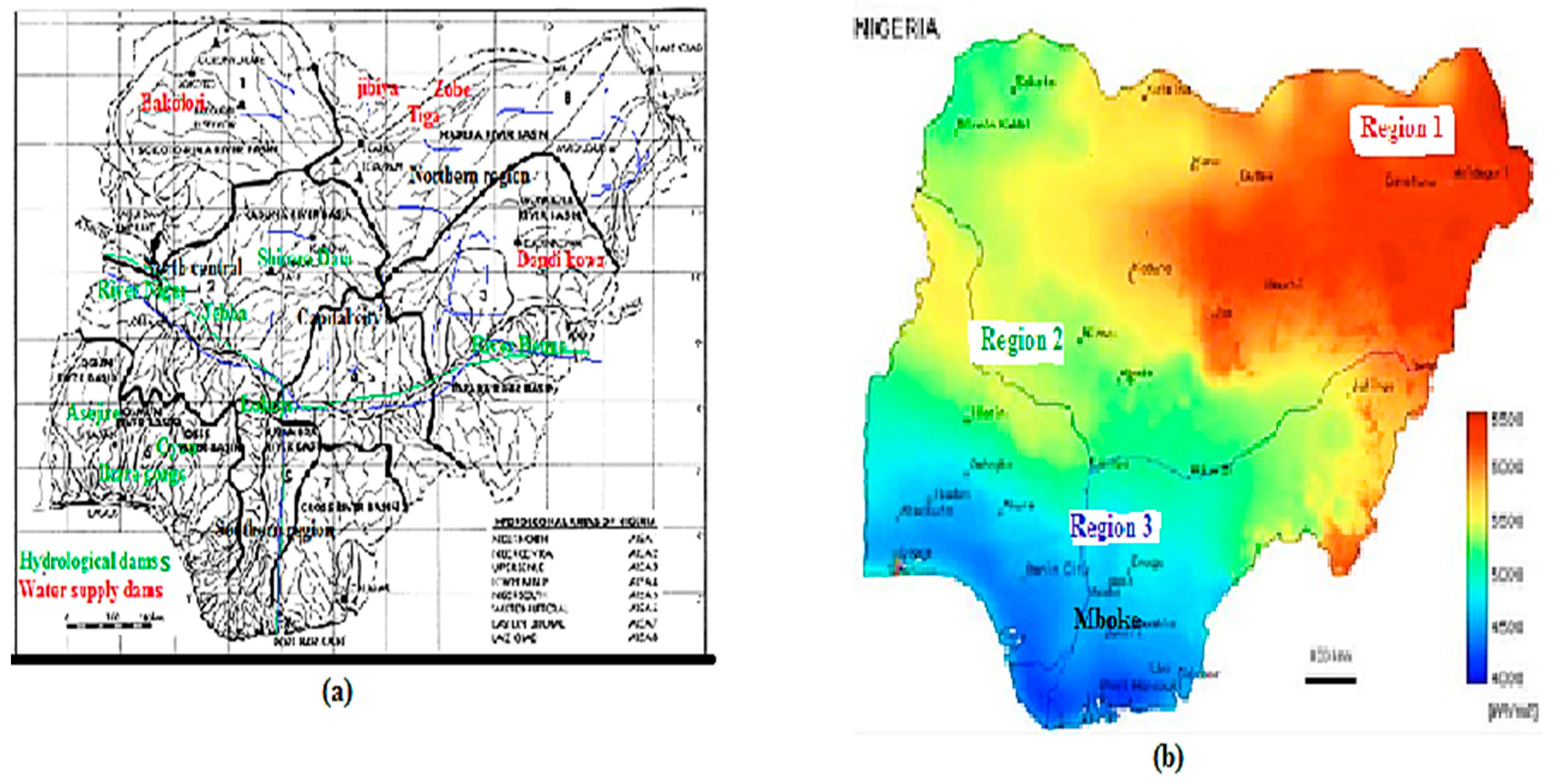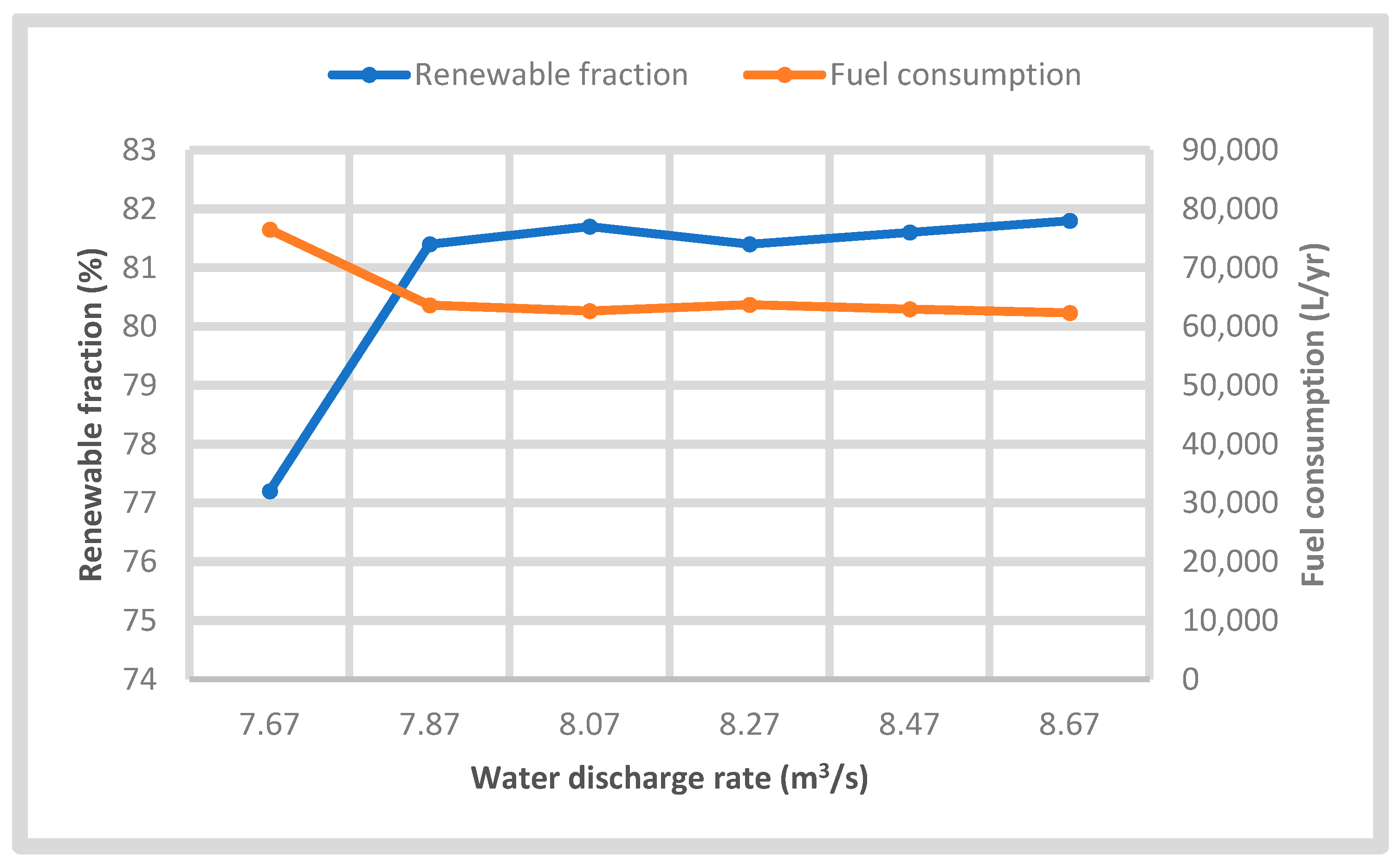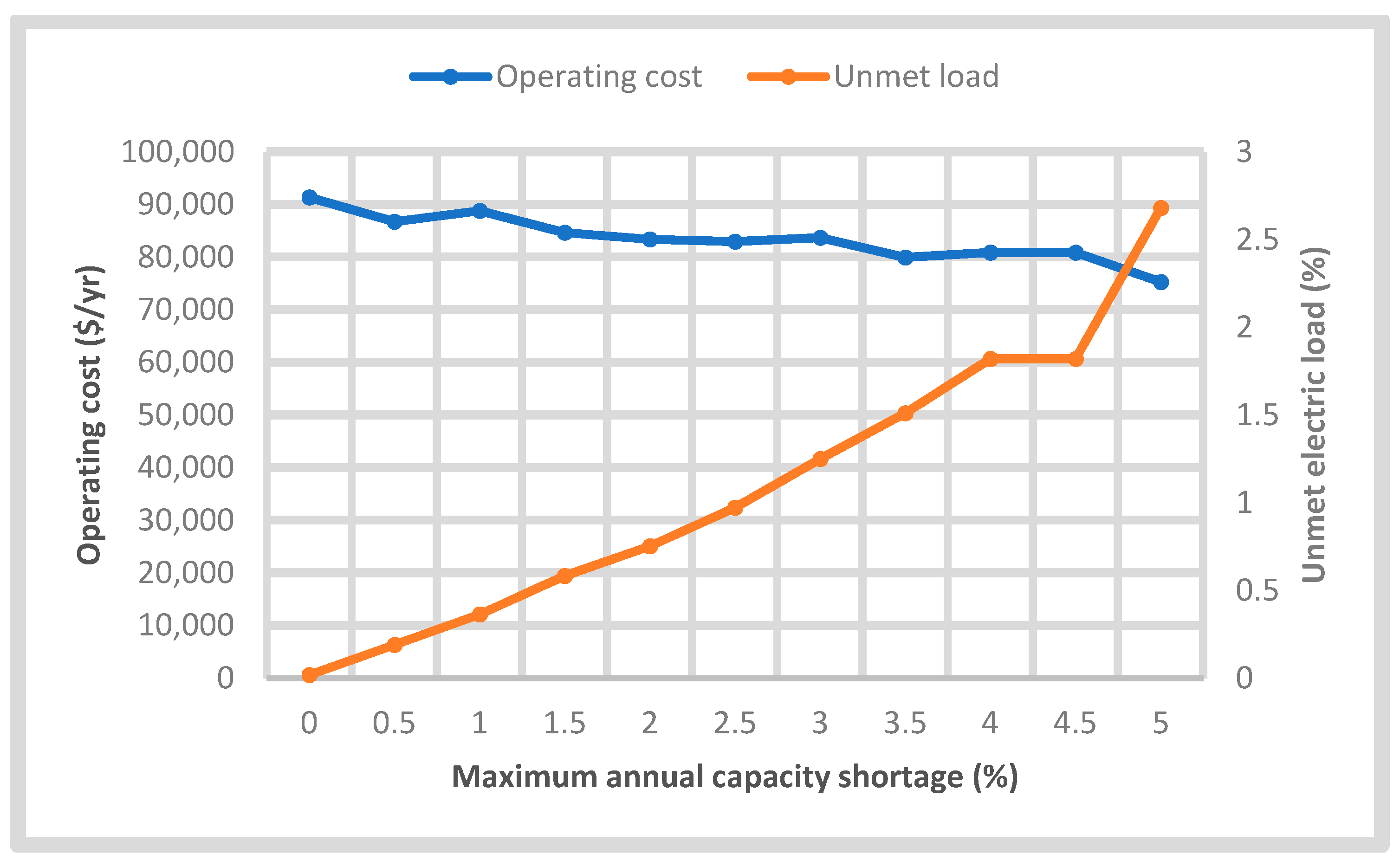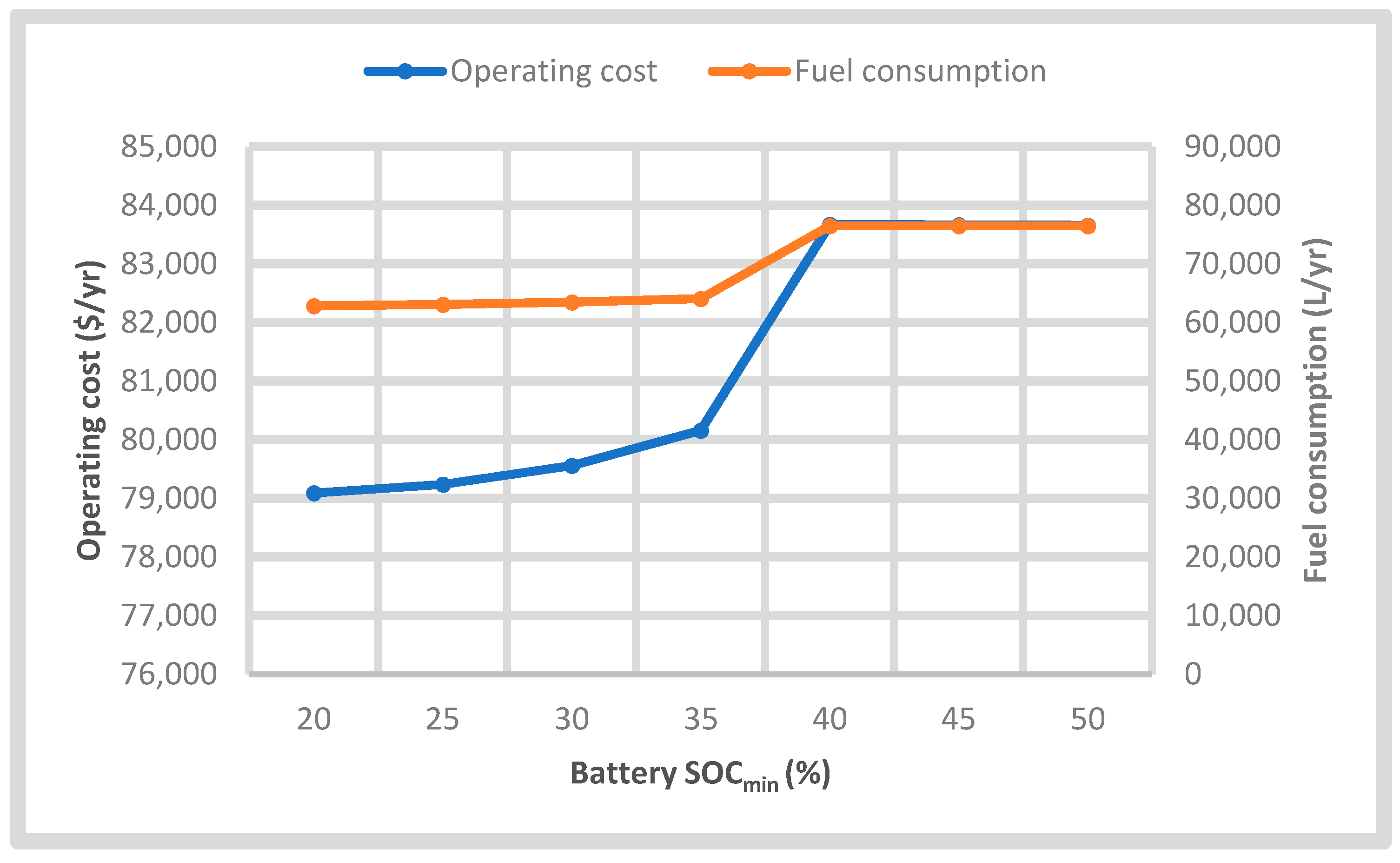Optimal Design of a Hybrid PV Solar/Micro-Hydro/Diesel/Battery Energy System for a Remote Rural Village under Tropical Climate Conditions
Abstract
:1. Introduction
2. Potential Renewable Energy Resources in Nigeria
3. Methods and Material
3.1. Specifications of the Selected Location
3.2. Proposed Hybrid Generation System and Load Profile Analysis
3.3. Hybrid System Design Specifications
3.4. Hybrid System Components and Costs
3.5. Mathematical Model
3.5.1. Modeling of a Hydropower System
3.5.2. Modeling of a PV System and Temperature
3.5.3. Modeling of Economic Parameters
4. Results and Discussion
4.1. Optimization Results
4.2. Environmental Analysis
4.3. Sensitivity Assessment
4.3.1. Real Interest Rate
4.3.2. Renewable Energy Component Parameters
4.3.3. Maximum Annual Capacity Shortage (MACS)
4.3.4. Battery Minimum State of Charge (SOCmin)
5. Conclusions
Author Contributions
Funding
Acknowledgments
Conflicts of Interest
References
- Okafor, N.; Sunmola, A.; Onwuzu, F.; Inyang, M.; Udoma, U. Recent initiatives to reform the Nigerian electricity market. Pract. Law UK Artic. 2018, 1–11. Available online: https://uk.practicallaw.thomsonreuters.com/w-013-8954 (accessed on 15 November 2019).
- Williams, A.; Porter, S. Comparison of hydropower options for developing countries with regard to the environmental, social and economic aspects. Small 2006, 1, 10. [Google Scholar]
- Renewable, I.; Agency, E. Off-Grid Renewable Energy Solutions to Expand Electricity Access: An Opportunity Not to Be Missed. Available online: https://www.irena.org/-/media/Files/IRENA/Agency/Publication/2019/Jan/IRENA_Off-grid_RE_Access_2019.pdf (accessed on 15 November 2019).
- Sambo, A. Strategic developments in renewable energy in Nigeria. Int. Assoc. Energy Econ. 2009, 16, 15–19. [Google Scholar]
- Shaaban, M.; Petinrin, J.O. Renewable energy potentials in Nigeria: Meeting rural energy needs. Renew. Sustain. Energy Rev. 2014, 29, 72–84. [Google Scholar] [CrossRef]
- United Nations Framework Convention on Climate Change Kyoto Protocol. Available online: https://unfccc.int/kyoto_protocol (accessed on 15 November 2019).
- The Worldbank Sustainable Energy for All (SE4ALL). Available online: https://data.worldbank.org/indicator/eg.fec.rnew.zs (accessed on 15 November 2019).
- Rezzouk, H.; Mellit, A. Feasibility study and sensitivity analysis of a stand-alone photovoltaic-diesel-battery hybrid energy system in the north of Algeria. Renew. Sustain. Energy Rev. 2015, 43, 1134–1150. [Google Scholar] [CrossRef]
- Oyedepo, S.O. Energy and sustainable development in Nigeria: The way forward. Energy Sustain. Soc. 2012, 2, 1–17. [Google Scholar] [CrossRef] [Green Version]
- Shaahid, S.M.; El-Amin, I. Techno-economic evaluation of off-grid hybrid photovoltaic-diesel-battery power systems for rural electrification in Saudi Arabia-A way forward for sustainable development. Renew. Sustain. Energy Rev. 2009, 13, 625–633. [Google Scholar] [CrossRef]
- Mandal, S.; Das, B.K.; Hoque, N. Optimum sizing of a stand-alone hybrid energy system for rural electrification in Bangladesh. J. Clean. Prod. 2018, 200, 12–27. [Google Scholar] [CrossRef]
- Aziz, A.S.; Tajuddin, M.F.N.; Adzman, M.R.; Azmi, A.; Ramli, M.A.M. Optimization and sensitivity analysis of standalone hybrid energy systems for rural electrification: A case study of Iraq. Renew. Energy 2019, 138, 775–792. [Google Scholar] [CrossRef]
- Das, H.S.; Yatim, A.H.M.; Tan, C.W.; Lau, K.Y. Proposition of a PV/tidal powered micro-hydro and diesel hybrid system: A southern Bangladesh focus. Renew. Sustain. Energy Rev. 2016, 53, 1137–1148. [Google Scholar] [CrossRef]
- Imam, A.A.; Al-turki, Y.A.; Kumar, R.S. Techno-economic feasibility assessment of grid-connected PV systems for residential buildings in Saudi Arabia—A Case Study. Sustainability 2020, 12, 262. [Google Scholar] [CrossRef] [Green Version]
- Aderemi, B.A.; Daniel Chowdhury, S.P.; Olwal, T.O.; Abu-Mahfouz, A.M. Techno-economic feasibility of hybrid solar photovoltaic and battery energy storage power system for a mobile cellular base station in Soshanguve, South Africa. Energies 2018, 11, 1572. [Google Scholar] [CrossRef] [Green Version]
- El-houari, H.; Allouhi, A.; Rehman, S.; Buker, M.S. Design, simulation, and economic optimization of an off-grid photovoltaic system for rural electrification. Energies 2019, 12, 4735. [Google Scholar] [CrossRef] [Green Version]
- IRENA. Renewable Power Generation Costs in 2018; International Renewable Energy Agency: Masdar City, Abu Dhabi, UAE, 2019.
- Masson, G.; Kaizuka, I.; Nowak, S.; Brunisholz, M.; Serra, G.; Cambiè, C.; Neubourg, G. Trends 2018 in Photovoltaics Applications; Survey Report of Selected IEA Countries between 1992 and 2017; International Energy Agency: St. Ursen, Switzerland, 2018; pp. 43–49. ISBN 9783906042794.
- Abdilahi, A.M.; Mohd Yatim, A.H.; Mustafa, M.W.; Khalaf, O.T.; Shumran, A.F.; Mohamed Nor, F. Feasibility study of renewable energy-based microgrid system in Somaliland’s urban centers. Renew. Sustain. Energy Rev. 2014, 40, 1048–1059. [Google Scholar] [CrossRef]
- Okoye, C.O.; Oranekwu-Okoye, B.C. Economic feasibility of solar PV system for rural electrification in Sub-Sahara Africa. Renew. Sustain. Energy Rev. 2018, 82, 2537–2547. [Google Scholar] [CrossRef]
- Lamidi, R.O.; Jiang, L.; Wang, Y.; Pathare, P.B.; Aguilar, M.C.; Wang, R.; Eshoul, N.M.; Roskilly, A.P. Techno-economic analysis of a cogeneration system for post-harvest loss reduction: A case study in sub-Saharan rural community. Energies 2019, 12, 872. [Google Scholar] [CrossRef] [Green Version]
- Bhandari, B.; Lee, K.T.; Lee, C.S.; Song, C.K.; Maskey, R.K.; Ahn, S.H. A novel off-grid hybrid power system comprised of solar photovoltaic, wind, and hydro energy sources. Appl. Energy 2014, 133, 236–242. [Google Scholar] [CrossRef]
- Ramli, M.A.M.; Hiendro, A.; Al-Turki, Y.A. Techno-economic energy analysis of wind/solar hybrid system: Case study for western coastal area of Saudi Arabia. Renew. Energy 2016, 91, 374–385. [Google Scholar] [CrossRef]
- Sofimieari, I.; Wazir, M.; Mustafa, B.; Obite, F. Modelling and analysis of a PV/wind/diesel hybrid standalone microgrid for rural electrification in Nigeria. Bull. Electr. Eng. Inform. 2019, 8, 1468–1477. [Google Scholar] [CrossRef]
- Salisu, S.; Wazir, M.; Olatomiwa, L. Assessment of technical and economic feasibility for a hybrid PV-wind-diesel-battery energy system in a remote community of north central Nigeria. Alex. Eng. J. 2019, 58, 1103–1118. [Google Scholar] [CrossRef]
- Kolhe, M.L.; Ranaweera, K.M.I.U.; Gunawardana, A.G.B.S. Techno-economic sizing of off-grid hybrid renewable energy system for rural electrification in Sri Lanka. Sustain. Energy Technol. Assess. 2015, 11, 53–64. [Google Scholar] [CrossRef]
- Adaramola, M.S.; Paul, S.S.; Oyewola, O.M. Assessment of decentralized hybrid PV solar-diesel power system for applications in northern part of Nigeria. Energy Sustain. Dev. 2014, 19, 72–82. [Google Scholar] [CrossRef]
- Olatomiwa, L. Optimal configuration assessments of hybrid renewable power supply for rural healthcare facilities. Energy Rep. 2016, 2, 141–146. [Google Scholar] [CrossRef] [Green Version]
- Oladigbolu, J.O. Optimal Configuration and Economic Assessment of a Hybrid PV/diesel Energy System for Remote Rural healthcare load: An Approach towards Rural Development. Int. J. Sci. Eng. Res. 2019, 10, 1309–1313. [Google Scholar]
- Akinyele, D. Analysis of photovoltaic mini-grid systems for remote locations: A techno-economic approach. Int. J. Energy Res. 2018, 42, 1363–1380. [Google Scholar] [CrossRef]
- Brimmo, A.T.; Sodiq, A.; Sofela, S.; Kolo, I. Sustainable energy development in Nigeria: Wind, hydropower, geothermal and nuclear. Renew. Sustain. Energy Rev. 2017, 74, 474–490. [Google Scholar] [CrossRef]
- Iea Nigeria Renewable Energy Master Plan. Available online: https://www.iea.org (accessed on 16 November 2019).
- Uhunmwangho, R.; Odje, M.; Okedu, K.E. Comparative analysis of mini hydro turbines for Bumaji Stream, Boki, Cross River State, Nigeria. Sustain. Energy Technol. Assess. 2018, 27, 102–108. [Google Scholar] [CrossRef]
- Lawrence, O. The effects of global warming and climate variability on water resources development: A case study of Otamiri-Njaba River Basin of Imo State, Nigeria. Int. J. Res. Stud. Sci. Eng. Technol. 2017, 4, 22–31. [Google Scholar]
- Ohunakin, O.S.; Adaramola, M.S.; Oyewola, O.M.; Fagbenle, R.O. Solar energy applications and development in Nigeria: Drivers and barriers. Renew. Sustain. Energy Rev. 2014, 32, 294–301. [Google Scholar] [CrossRef]
- Shaahid, S.M.Ã.; Elhadidy, M.A. Economic analysis of hybrid photovoltaic–diesel–battery power systems for residential loads in hot regions—A step to clean future. Renew. Sustain. Energy Rev. 2008, 12, 488–503. [Google Scholar] [CrossRef]
- Ita, E.O. Aquatic Plants and Wetland Wildlife Resources of Nigeria. Available online: http://www.fao.org/3/t3660e/t3660e01.htm (accessed on 20 January 2020).
- Salisu, S.; Sadiq, B.O.; Abubakar, A.S.; Jibril, Y.; Garba, S. Solar Energy Efficient Building: A Feasibility Study in Sokoto State of Nigeria. Int. J. Sci. Eng. Res. 2014, 670. [Google Scholar]
- Nigeria Electricity System Operator. Available online: https://nsong.org/AboutUs/Locations.aspx (accessed on 19 January 2020).
- Olatomiwa, L.; Blanchard, R.; Mekhilef, S.; Akinyele, D. Hybrid renewable energy supply for rural healthcare facilities: An approach to quality healthcare delivery. Sustain. Energy Technol. Assess. 2018, 30, 121–138. [Google Scholar] [CrossRef] [Green Version]
- Ihiagwa, Moke Village Nigeria. Available online: https://en.wikipedia.org/wiki/Ihiagwa (accessed on 19 January 2020).
- Oviroh, P.O.; Jen, T. The energy cost analysis of hybrid systems and diesel generators in powering selected base transceiver station locations in Nigeria. Energies 2018, 11, 687. [Google Scholar] [CrossRef] [Green Version]
- Oladigbolu, J.O.; Ramli, M.A.M.; Al-turki, Y.A. Techno-economic and sensitivity analyses for an optimal hybrid power system which is adaptable and effective for rural electrification: A case study of Nigeria. Sustainability 2019, 11, 4959. [Google Scholar] [CrossRef] [Green Version]
- Obi, L.; Law-Obi, F. Small hydropower development: Key for sustainable rural electric power generation in Imo State of Nigeria. Int. J. Adv. Res. Sci. Technol. 2016, 3, 1275–1284. [Google Scholar]
- NASA/SSE. Surface Meteorology and Solar Energy. Available online: https://power.larc.nasa.gov/ (accessed on 16 October 2019).
- Ogueke, N.V.; Ikpamezie, I.I.; Anyanwu, E.E. The potential of a small hydro/photovoltaic hybrid system for electricity generation in FUTO, Nigeria. Int. J. Ambient Energy 2016, 37, 256–265. [Google Scholar] [CrossRef]
- Givler, T.; Lilienthal, P. Using HOMER Software, NREL’s Micropower Optimization Model, to Explore the Role of Gen-Sets in Small Solar Power Systems; Case Study: Sri Lanka; National Renewable Energy Lab.: Golden, CO, USA, 2005; Volume 3.
- HOMER Energy. HOMER Pro Version 3.7 User Manual; HOMER Energy: Boulder, CO, USA, 2016; Volume 7. [Google Scholar]
- Gilman, P.; Lilienthal, P. Micropower System Modeling with Homer. In Integration of Alternative Sources of Energy; Felix, A., Farret, M., Godoy, S., Eds.; John Wiley & Sons, Inc.: Hoboken, NJ, USA, 2006; pp. 379–418. [Google Scholar]
- Global Petrol Prices. Available online: https://www.globalpetrolprices.com/Nigeria/diesel_prices/ (accessed on 23 May 2020).
- Oladigbolu, J.O. Economic evaluation and determination of optimal hybrid energy supply systems for residential and healthcare facilities in rural and urban areas. King Abdulaziz Univ. Sci. Publ. Cent. 2020, 1–99. [Google Scholar]
- Ngan, M.S.; Tan, C.W. Assessment of economic viability for PV/wind/diesel hybrid energy system in southern Peninsular Malaysia. Renew. Sustain. Energy Rev. 2012, 16, 634–647. [Google Scholar] [CrossRef]




















| Component Parameters/Reference | Specification |
|---|---|
| 1. PV panel [12,40] | |
| Efficiency at the standard test condition | 13% |
| Temperature coefficient | −0.48%/°C |
| Initial cost | $3200/kW |
| Cost of replacement | $3000/kW |
| Operating and maintenance cost | $5/kW/year |
| 2. Hydropower system [12] | |
| Initial cost | $1700/kW |
| Cost of replacement | $500/kW |
| Operating and maintenance cost | $100/year |
| Efficiency | 75% |
| 3. Battery [43] | |
| Model | Surrette 6CS25P |
| Nominal voltage | 6 V |
| Nominal capacity | 6.94 kWh |
| Initial cost | $1100 |
| Cost of replacement | $1100 |
| Operating and maintenance cost | $10/year |
| 4. Converter [40] | |
| Capital cost | $245/kW |
| Cost of replacement | $245/kW |
| Operating and maintenance cost | $10/year |
| Efficiency | 90% |
| 5. Diesel generator [40] | |
| Initial cost | $200/kW |
| Cost of replacement | $200/kW |
| Maintenance cost | $0.05/kW/h |
| Minimum load ratio | 25% |
| PV (kW) | DG (kW) | Battery | Hydro (kW) | Converter (kW) | DS | NPC ($) | COE ($/kWh) | Operating Cost ($/year) | Renewable Fraction (%) | Diesel (L) | Average Generator Hours (h/yr) |
|---|---|---|---|---|---|---|---|---|---|---|---|
| 50 | 100 | 16 | 94.1 | 50 | CC | 963,431 | 0.112 | 83,667 | 77.2 | 76,492 | 4705 |
| 200 | - | 376 | 94.1 | 200 | LF | 2.17 M | 0.254 | 127,674 | 100 | - | - |
| 50 | 220 | 48 | - | 100 | CC | 2.60 M | 0.301 | 327,396 | 1.25 | 326,073 | 7577 |
| 50 | 250 | - | - | 50 | LF | 2.70 M | 0.312 | 348,970 | 1.30 | 334,200 | 8760 |
| Pollutant | Proposed PV/Hydro/Diesel/Battery System (kg/year) | PV/Diesel System (kg/year) |
|---|---|---|
| Carbon dioxide | 200,247 | 874,890 |
| Carbon monoxide | 1250 | 5461 |
| Unburned hydrocarbons | 55.1 | 241 |
| Particulate matter | 7.50 | 32.8 |
| Sulfur dioxide | 490 | 2142 |
| Nitrogen oxides | 1175 | 5133 |
© 2020 by the authors. Licensee MDPI, Basel, Switzerland. This article is an open access article distributed under the terms and conditions of the Creative Commons Attribution (CC BY) license (http://creativecommons.org/licenses/by/4.0/).
Share and Cite
Oladigbolu, J.O.; Ramli, M.A.M.; Al-Turki, Y.A. Optimal Design of a Hybrid PV Solar/Micro-Hydro/Diesel/Battery Energy System for a Remote Rural Village under Tropical Climate Conditions. Electronics 2020, 9, 1491. https://doi.org/10.3390/electronics9091491
Oladigbolu JO, Ramli MAM, Al-Turki YA. Optimal Design of a Hybrid PV Solar/Micro-Hydro/Diesel/Battery Energy System for a Remote Rural Village under Tropical Climate Conditions. Electronics. 2020; 9(9):1491. https://doi.org/10.3390/electronics9091491
Chicago/Turabian StyleOladigbolu, Jamiu Omotayo, Makbul A. M. Ramli, and Yusuf A. Al-Turki. 2020. "Optimal Design of a Hybrid PV Solar/Micro-Hydro/Diesel/Battery Energy System for a Remote Rural Village under Tropical Climate Conditions" Electronics 9, no. 9: 1491. https://doi.org/10.3390/electronics9091491
APA StyleOladigbolu, J. O., Ramli, M. A. M., & Al-Turki, Y. A. (2020). Optimal Design of a Hybrid PV Solar/Micro-Hydro/Diesel/Battery Energy System for a Remote Rural Village under Tropical Climate Conditions. Electronics, 9(9), 1491. https://doi.org/10.3390/electronics9091491





